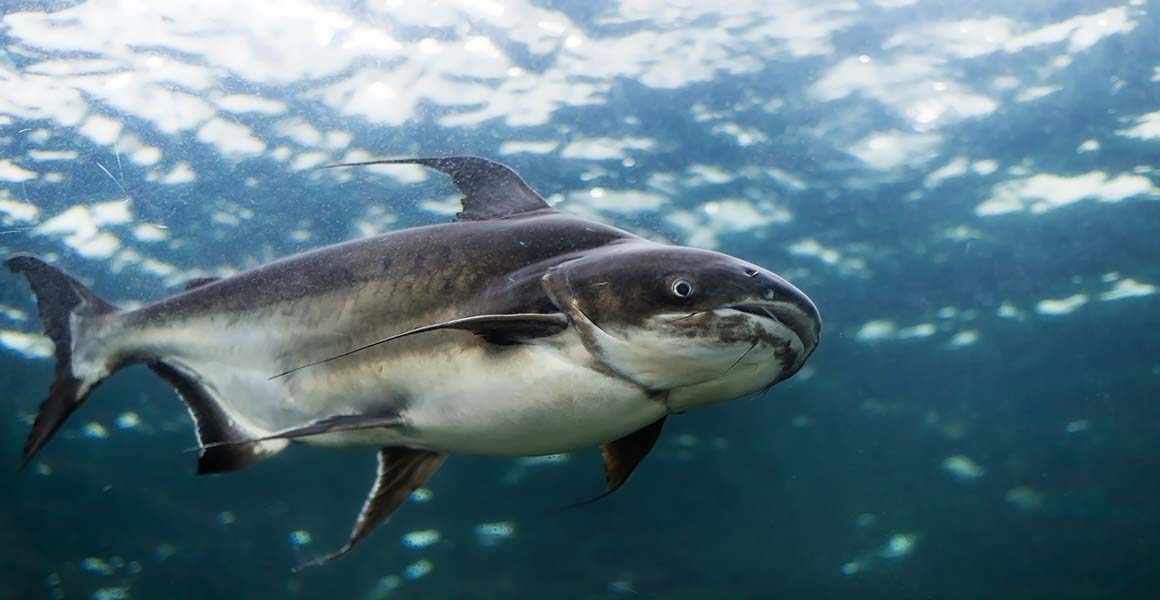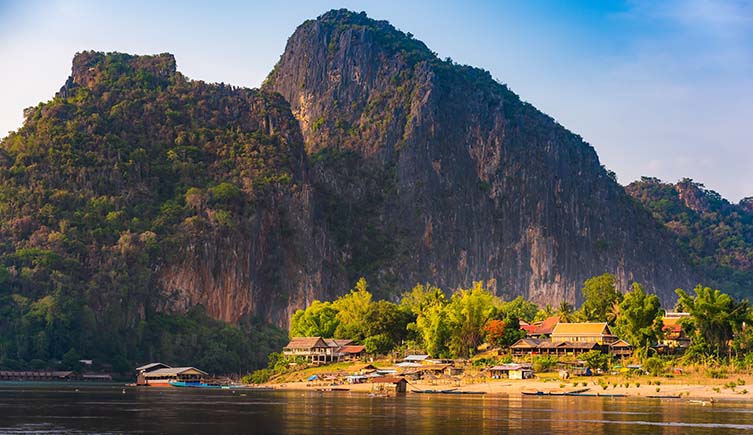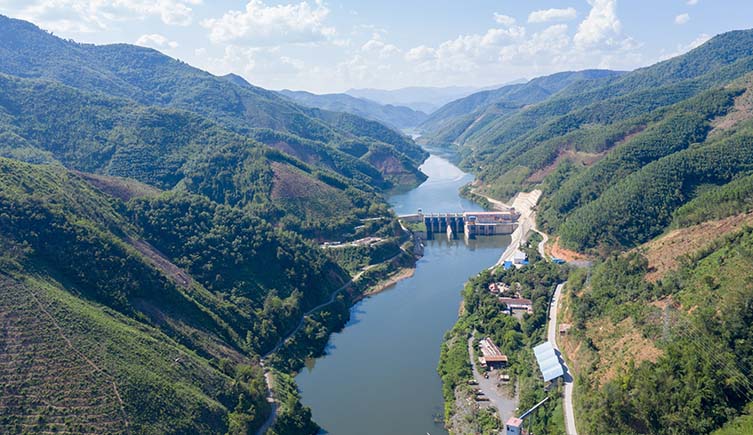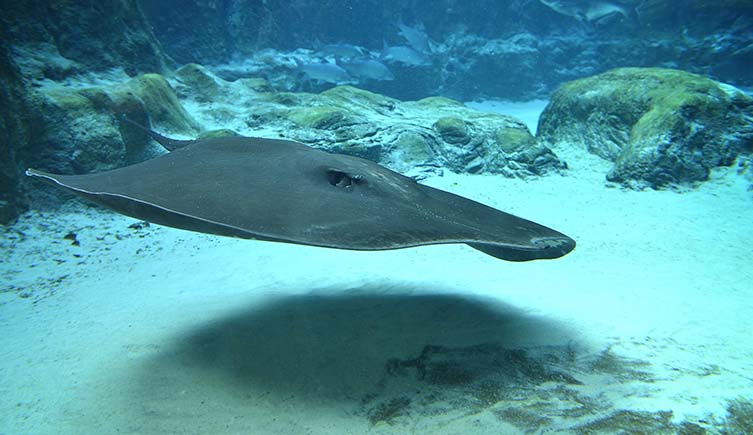Some of the world’s largest and most unusual fishes could be wiped out.
Without urgent action, dam building and unsustainable fishing could drive the Mekong giant catfish and giant freshwater stingray to extinction.

The Mekong giant catfish is classed as Critically Endangered following years of overfishing and habitat destruction. Image © taratipman/Shutterstock.
Some of the world’s largest and most unusual fishes could be wiped out.
Without urgent action, dam building and unsustainable fishing could drive the Mekong giant catfish and giant freshwater stingray to extinction.
One of the world’s most diverse rivers is under threat.
Thousands of different species live in the Mekong River, which flows for almost 5,000 kilometres through much of southeast Asia. Some of the world’s biggest fishes live in the river, including the largest freshwater fish, the giant freshwater stingray, and the giant barb, a carp that can weigh as much as 300 kilograms.
However, these aquatic giants may soon pass into legend. A report from the World Wide Fund for Nature (WWF) reveals that dams, sand mining and pollution mean that of those assessed, over a fifth of the Mekong’s fish are at risk of extinction – though the true figure is likely higher.
Lan Mercado, the WWF’s Asia-Pacific Regional Director, says, ‘The alarming decline in fish populations in the Mekong is an urgent wake-up call for action to save these extraordinary species, which underpin not only the region’s societies and economies but also the health of the Mekong’s freshwater ecosystems.’
‘These fishes have swum through our civilizations and cultures for millennia and millions of people still depend on them every day. But overlooked by decision makers, they are disappearing. We must act now to reverse this disastrous trend because the communities and countries of the Mekong cannot afford to lose them.’

The Mekong River flows though China, Myanmar, Laos, Thailand, Cambodia and Vietnam. Image © sittitap/Shutterstock.
The Mekong lies at the heart of southeast Asia, passing through different cultures, beliefs and countries on its way to the sea. As it flows, it carries nutrients and sediments that underlie one of the richest ecosystems on Earth.
Over 1,100 species of fish call the Mekong home, making it the third most species-rich river anywhere in the world after the Amazon and Congo basins. Unlike these areas, however, the Mekong basin is much smaller, concentrating its biodiversity into a reduced area.
These waters also maintain what some consider the Earth’s largest migration, as over five billion fish swim up the river every year to spawn.
The sheer number of fish in the Mekong drives the largest inland fishery in the world, which is thought to be worth £8.6 billion a year. In turn, this supports two thirds of households in the lower Mekong basin, with over 40 million people either working in the industry or depending on it for food.

Dams on the Mekong River get in the way of fish migrating to their spawning grounds. Image © stock hunter/Shutterstock.
Unfortunately, the diversity and prosperity of the river is at risk. Unsustainable construction, fishing and resource extraction are pushing the Mekong to the brink, with dams a particular issue.
Dr Rupert Collins, the Natural History Museum’s Senior Curator of Fishes, contributed to the report. He says, ‘There are two big problems with dams in general. Firstly, large hydroelectric dams reduce connectivity, preventing the migration of species like the large catfish and making it harder for these animals to reproduce. As fewer mature fish make the spawning sites, then populations will fall.’
‘They also encourage wider development in their area, with many smaller dams often built nearby. These are frequently used to contain stocks of non-native food fish like tilapia, which can escape and outcompete native fishes for food and resources.’
Sand mining is also a serious problem, driven by demand for construction, glass and electronics. Removing sand affects the flow and depth of water in the river, changing the underwater environment and affecting the stability of riverbanks.
Together with other threats, including plastic pollution and habitat loss, this is putting the Mekong’s wildlife under pressure. Declining fish populations have also threatened the animals which prey on them, including the Irrawaddy dolphin. Only 90 of these endangered mammals remain in the river.
Falling fish stocks also mean reduced catches along the Mekong. Between 2015 and 2020, it’s estimated the value of the fishery plummeted by a third as the number of fish being caught fell.
Not only does this threaten the livelihoods of local people, but also the wider ecosystem. Replacing just half the amount of protein provided by Mekong fish with pork, for instance, would need an additional 52,000 square kilometres of land to be converted into pasture – an area around two and a half times the size of Wales.

The capture of a giant freshwater stingray in 2022 shows that the river can still support its large fish, if given a chance. Image © tristan tan/Shutterstock.
To tackle these issues, the WWF report calls on the nations through which the Mekong flows to sign up to a transboundary ‘Emergency Recovery Plan for Freshwater Biodiversity’. This plan is based on proposals from a 2020 study, which are divided into six key areas.
These include removing obsolete dams to let the Mekong and its tributaries flow more naturally, as well as steps to restore habitats and improve water quality.
Bringing the unsustainable harvesting of fish under control will also be vital. For example, with numbers of the Mekong giant catfish having fallen by 80% since the 1980s, this and other species must be allowed to recover.
It’s not a question of ending fishing in the Mekong, but instead taking a wider view of the river as a whole, rather than dividing it by countries. Introducing conservation zones in important areas, even if they cross boundaries, can provide spaces for fish populations to recover.
As this may limit catches by some fishers, it’s important to provide sustainable alternatives for income. Ecotourism is one potential option, as is a well-managed aquarium trade.
‘Around 14% of the Mekong’s fish species have been, at some point, involved in the aquarium trade,’ Rupert says. ‘While this figure appears large, many species are rarely captured, and these days popular fish tank staples are often bred from captive populations by commercial breeders.’
‘Though the proportion of wild-caught fish is very small, it can be problematic, especially when new and enigmatic species are discovered. It’s important to incentivise the sustainable management of wild-caught fish for this trade, giving rural people a livelihood and another reason to look after the river.’
If these actions are carried out, the report’s authors are confident that the Mekong can recover.
Kathy Hughes, the lead author, says, ‘Reversing decades of decline will be hard but it’s possible – if we act collectively and urgently.’
‘Local fishers and communities have shown that there is hope and, together, we can scale up their solutions. We can protect and restore the Mekong, and use it sustainably for the benefit of societies and economies now and in the future – a future in which the river’s extraordinary freshwater fishes survive and thrive.’

We're working towards a future where both people and the planet thrive.
Hear from scientists studying human impact and change in the natural world.
Don't miss a thing
Receive email updates about our news, science, exhibitions, events, products, services and fundraising activities. We may occasionally include third-party content from our corporate partners and other museums. We will not share your personal details with these third parties. You must be over the age of 13. Privacy notice.
Follow us on social media